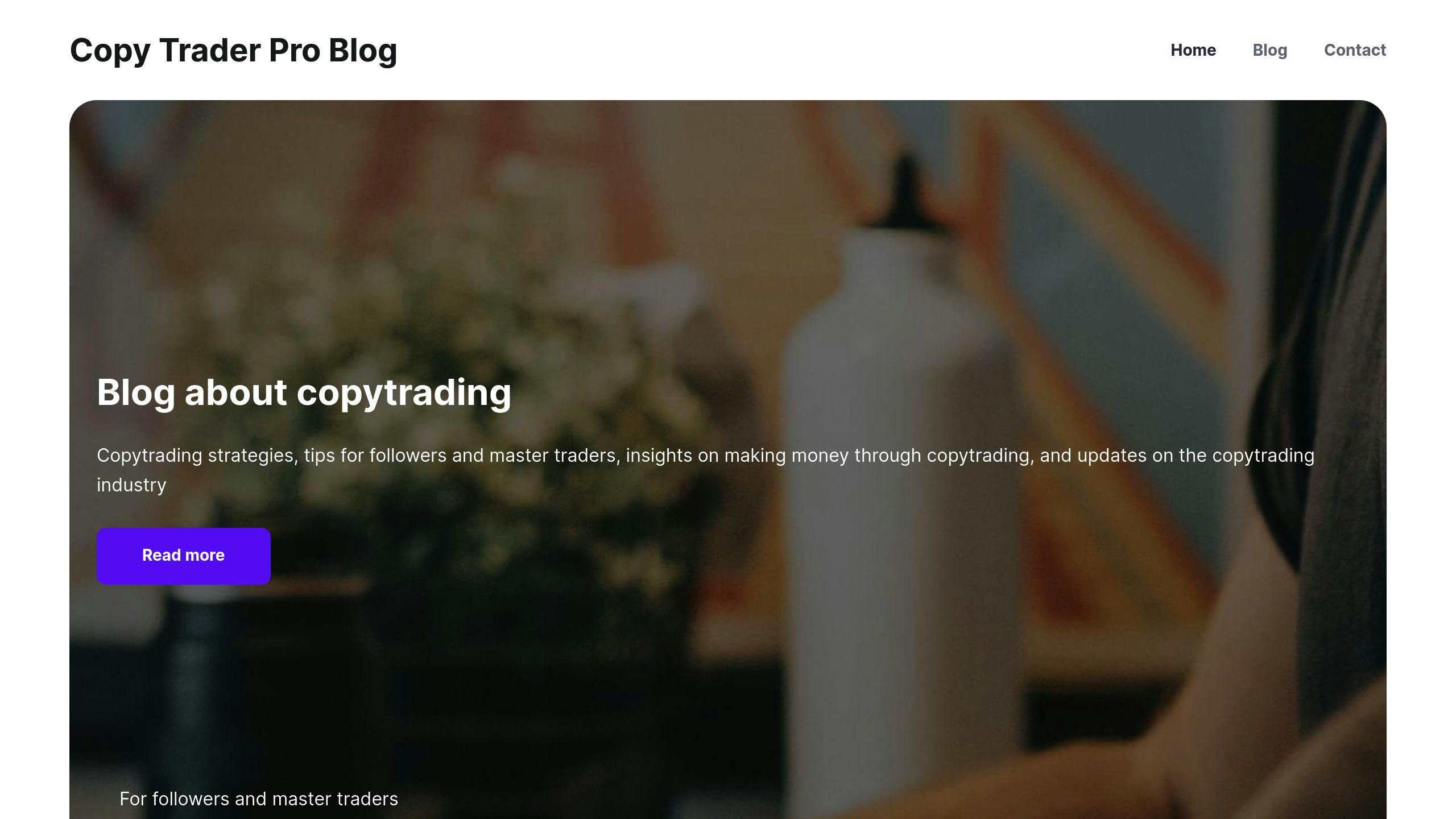
Want to succeed in copy trading? Start by tracking your profits effectively. Monitoring performance helps you evaluate traders, minimize risks, and calculate net returns after fees. Here’s a quick guide to staying on top of your investments:
- Key Metrics to Track: Profit/Loss (realized and unrealized), Risk-Adjusted Returns (like Sharpe Ratio), and Maximum Drawdown.
- Account for Fees: Include commissions, spreads, and platform fees to calculate actual ROI.
- Use Tools: Leverage dashboards, third-party analytics, or spreadsheets for detailed tracking.
- Automate Alerts: Set notifications for risk levels, profit thresholds, or changes in trader performance.
Metrics for Evaluating Copy Trading Profits
Understanding the right metrics is crucial for assessing how well your copy trading strategy is working. Here are the key indicators to help you make smarter investment decisions.
Profit and Loss
Profit and Loss (P&L) data gives you a clear snapshot of your trading results. To track your performance effectively, look at both absolute numbers and percentage changes over specific timeframes. For example, earning $1,000 on a $10,000 investment represents a 10% return, while losing $500 equals a -5% return.
Key elements of P&L to consider:
- Realized profits: Gains from trades that have been fully closed.
- Unrealized profits: Gains (or losses) from open positions that haven’t been finalized yet.
- Total portfolio value: The combined worth of both closed and open positions.
Risk-Adjusted Returns
Focusing only on profit doesn’t tell the whole story. Risk-adjusted metrics like the Sharpe Ratio can help by showing how much return you’re getting for the level of risk you’re taking. A higher Sharpe Ratio means better performance relative to risk.
Another critical measure is maximum drawdown, which shows the largest drop in your portfolio’s value from a peak. For instance, a 10% drawdown is far easier to recover from than a 30% drop.
Impact of Fees and Costs
Fees can eat into your profits, so keeping track of them is essential. Here’s a breakdown of common costs:
| Fee Type | Description | Impact on Profits |
|---|---|---|
| Commission | Charged per trade by the platform | 5-10% of profits |
| Spread | Difference between buy and sell prices | Varies by asset |
| Platform Fees | Monthly or annual service charges | Fixed cost |
To find your actual return on investment (ROI), use this formula:
Net ROI = ((Gross Return – Total Costs) / Investment Cost) × 100%
For example, if you earn $1,000 on a $10,000 investment but pay $100 in fees, your net ROI would drop to 9% instead of the gross 10%.
"It is essential to evaluate if results have been positive or negative throughout each stage of a competing market cycle." – מיטל כהן, Naturopathic Practitioner [1]
With these metrics in mind, you’re better equipped to assess performance. Next, we’ll look at how copy trading platforms can help you track and analyze these metrics efficiently.
Using Copy Trading Platforms to Monitor Performance
Dashboard Features Overview
Dashboards on copy trading platforms make it easier to keep tabs on performance. They provide a clear way to track key metrics like profit/loss (P&L) and risk-adjusted returns, helping you make informed decisions.
Here’s a breakdown of common dashboard features:
| Feature | What It Does |
|---|---|
| Performance Charts | Displays profit and loss trends over time |
| Risk Metrics | Shows real-time data like the Sharpe ratio and drawdown levels |
| Portfolio Overview | Tracks active positions, allocations, and diversification |
| Trade History | Lets you review past trades to evaluate performance |
Many platforms also include interactive charts, making it easier to dive into the details. These tools provide a deeper understanding of how your portfolio behaves under various market conditions.
Customizing Your Dashboard
Tailoring your dashboard ensures it reflects the metrics that matter most to your trading strategy. For example, platforms like WeCopyTrade allow users to design custom layouts to focus on their preferred indicators [2].
Key Metrics to Highlight: Keep an eye on portfolio value, daily changes, trader performance, risk exposure, and how fees impact returns.
Set Up Alerts: Configure alerts for specific triggers like profit/loss thresholds, changes in risk, updates to trader strategies, or warnings about drawdowns.
Position your most critical metrics front and center, and consider using separate views for short-term and long-term tracking. While dashboards offer a strong foundation for performance monitoring, additional tools can provide even deeper insights.
sbb-itb-c34bd9b
Advanced Tools for Performance Tracking and Analysis
Using Third-Party Analytics
Dashboards are great for basic metrics, but third-party tools can take your analysis to the next level. Platforms like TradingView help you dig deeper into performance trends, trader correlations, and custom reporting.
Some standout features include:
- Correlations: Understand how copied traders’ strategies interact.
- Risk-Adjusted Returns: Evaluate performance under different market conditions.
- Custom Reports: Build reports tailored to your specific needs.
If you prefer a more hands-on approach, manual tracking might be your style.
Manual Tracking with Spreadsheets
Spreadsheets give you complete control over your data, making them perfect for users who want detailed, customized analysis.
A well-organized spreadsheet might include columns like:
| Column | Purpose | Example Metric |
|---|---|---|
| Trade Date | Record entry/exit timing | Jan 15, 2025 |
| Copied Trader | Track performance by trader | @TraderName |
| Position Size | Monitor risk exposure | $1,000 |
| P/L | Calculate trade outcome | +$50 |
| Cumulative ROI | Track overall returns | 12.5% |
While this method offers flexibility, it can be time-consuming. Automated tools are often a better choice for routine tracking.
Automated Reporting Systems
Automated systems simplify tracking by providing scheduled updates and real-time alerts, saving you time and reducing errors.
Key advantages include:
- Instant Alerts: Get notified when metrics hit critical thresholds.
- Regular Summaries: Receive daily, weekly, or monthly performance reports.
- Platform Integration: Combine data from multiple copy trading platforms for a unified view.
"Copy trading can streamline the trading process as it is easier to learn than other forms of investments. It does not require a lot of research from the followers and enables them to customize their portfolios easily." – STARTRADER, "Copy Trading: Profitability Insights" [4]
When setting up automated reports, focus on metrics that matter most to your strategy. For example, configure alerts for changes in ROI, risk levels, or trader activity that could impact your portfolio.
Conclusion: Key Points for Monitoring Copy Trading Profits
Key Metrics to Watch
To succeed in copy trading, it’s crucial to keep a close eye on important performance indicators. Focus on metrics like monthly returns (aim for 5-7% on average), win rate (target above 50%), risk-adjusted returns, and drawdown levels (keep these below 20%) [2]. These metrics, which were covered earlier, give you a clear picture of your portfolio’s overall health and performance trends.
Tracking these numbers consistently can help you stay on top of your investments. However, metrics alone won’t guarantee success – your actions based on these insights matter just as much.
Tips for Staying Profitable
Staying profitable in copy trading requires a disciplined approach to monitoring and managing risks. Dedicate time each week to review the performance of your copied traders and compare their results to current market trends [1].
Here are some strategies to help:
- Diversify your portfolio by following multiple traders and adjusting trade sizes based on results.
- Use platform tools like stop-loss orders to manage risks effectively.
- Keep track of all fees when calculating your profits.
Using tools like automated reporting systems or third-party analytics, as mentioned earlier, can simplify the process of monitoring these metrics and applying these strategies.
"Copy trading takes patience, discipline, and a long-term outlook." [3]
Explore More on COP.YT Blog

For detailed guides on metrics, risk management, and platform tools, check out the COP.YT Blog. The platform provides tailored resources for both followers and master traders, offering insights into the latest trends and analytics in copy trading.
Some of the blog’s highlights include:
- Deep dives into performance metrics
- Risk management techniques
- Platform-specific tools for tracking progress
- Market trend analysis and updates
FAQs
How to calculate ROI for trading?
To calculate ROI (Return on Investment) in trading, use this formula:
ROI = (Profit / Cost of Investment) × 100
For instance, if you invest $1,000 in copy trading and earn a $200 profit, your ROI would be: ($200 / $1,000) × 100 = 20%.
When calculating ROI in copy trading, keep these points in mind:
- Factor in all associated costs, such as platform fees and profit-sharing agreements.
- Use only closed positions for calculations, accounting for stop-loss amounts to ensure accuracy.
Most platforms provide dashboards that display key metrics like total investment, profit/loss, and open positions. Use these tools to track your ROI effectively. Reviewing your ROI weekly or monthly helps you stay informed and refine your strategy as needed.
ROI, combined with other metrics like risk-adjusted returns and drawdown levels, offers a clearer picture of your trading results. Regularly calculating ROI enables you to assess your performance and make informed adjustments to your trading approach [1].
Related Blog Posts
RELATED POSTS
View all


